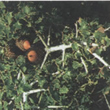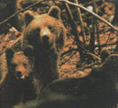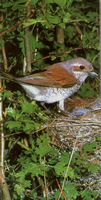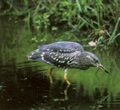THE ENVIRONS OF THE CITY OF SERRES
Following the incorporation of Agios Ioannis and Oinousa to the east, and Elaionas to the north-east, the area constituting the Municipality of Serres now incorporates mountainous areas as high as 1,800 metres above sea level.This somewhat topsy-turvy territorial expansion has increased the variety of terrain and weather conditions within the Municipality, thus providing favourable conditions for the appearance of a mosaic of bio-communities, and in turn, a variety of ecosystems or geobiocommunities.Most of these ecosystems bear the scars of the human intervention which has taken place on a large scale at various times over the centuries. However, it should be noted that the area is nevertheless still one of rare natural beauty; a fact which is clearly reflected in the number of species present in the bio-communities which make use of its range of ecosystems.
 |
Juniperus communis |
 |
Columba venus |
 |
Anas platyrhynchios |
OUTSTANDING CHARACTERISTICS OF THE AREA
To the north of the city (The watercourses of Agios Georgios in Elaionas, Agioi Anargyri in Oreini, and Agia Barbara in Kamenikia)Exhausted by constant invasions, raids, and attacks, the local population found itself struggling to survive in a situation where their only reliable source of income came from their natural environment. Thus it was that logging in the oak forests, stock raising and the land clearance this requires, along with other forms of long-term human intervention in the physical environment led to its wholesale destruction. This is especially true of the area to the north of the city of Serres, which suffered depopulation, erosion, and downgrading.
 |
Lepus europaeus |
 |
Upopa epops |
The deep furrows in the land - which even today are believed by some to be a curious natural phenomenon - and other features of the area, such as the instability of its terrain, the absence of top soil, the loss of good soil buried under bad, destruction by floods, and the deterioration in its climate are all consequences of that selfsame unregulated human intervention in the environment. Of course, these changes in their turn brought economic disaster and social instability to the area.Work started in 1930 on redirecting watercourses thought the area, which brought the loss of land to a halt, and significantly lessened erosion and the flood damage that had cost the area so dearly, both financially and in terms of human life.
Nature set to work as fast as she could at repairing the damage sustained due to unrestrained human activity. Reliable estimates as to variety and species counts show that the area's flora and fauna are flourishing once more, and a total of 35 square kilometres of arable land have been saved.To the Northeast (Mount Menoikios - the waterway of the Monastery of the Timios Prodromos)
 |
Aquila chrysaetos |
 |
Ardea purpurea |
 |
Nycticoran nycticoran
|
 |
|---|
| Prinus coccibera |
 |
|---|
| Phalacrocoran carbo |
Mount Menoikios lies to the north-east of the city of Serres. The mountainside - on which the Monastery of the Timios Prodromos is built - has not suffered from organised or long-term human activities such as logging. The monks of the Timios Prodromos protected the area from the people of Serres and the surrounding villages, and in consequence, the area has maintained its rich flora and fauna intact. Any intervention that took place was respectful of the environment, and was consequently integrated into local ecosystems.Today, the slopes of Mount Menoikios provide habitat for a number of rare animal and plant species.



